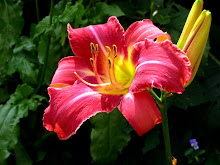
All fingers and toes are crossed in the hopes that the forecast is correct -- two days of rain, perhaps as much as two inches; it's already drizzling out there. It's been a tough season for lining out daylilies; they get dug out of dusty, dry soil, and I wince for them as I pull them out of the ground. A nice soak before they're replanted helps, and of course good watering-in, but in spite of my "tough-love" beliefs, I've been watering them regularly after that as well.
Once again I can be grateful for a good supply of mulch; put on top of the new plantings, it helps to hold in the moisture and delay the drying effects of wind and weather. Next year's new raspberry row is being prepped as well with sheets of newspapers topped with thick mulch, so that weeds will be discouraged and digging will be easier next spring when we're ready to plant.

New daylily additions have been planted in the last two weeks: Persian Pattern (above), Colorful Summer, Neal Berrey, Martha Custis, Shishedo, Rose Emily, Byzantine Emperor, South Seas, Dublin Elaine (at top of post), Cherokee Heritage, Victoria Grace, Ruffled Apricot. Three of the older cultivars have produced proliferations -- tiny little clone plants located on blossom stems -- and so I am attempting to root them in the greenhouse.




